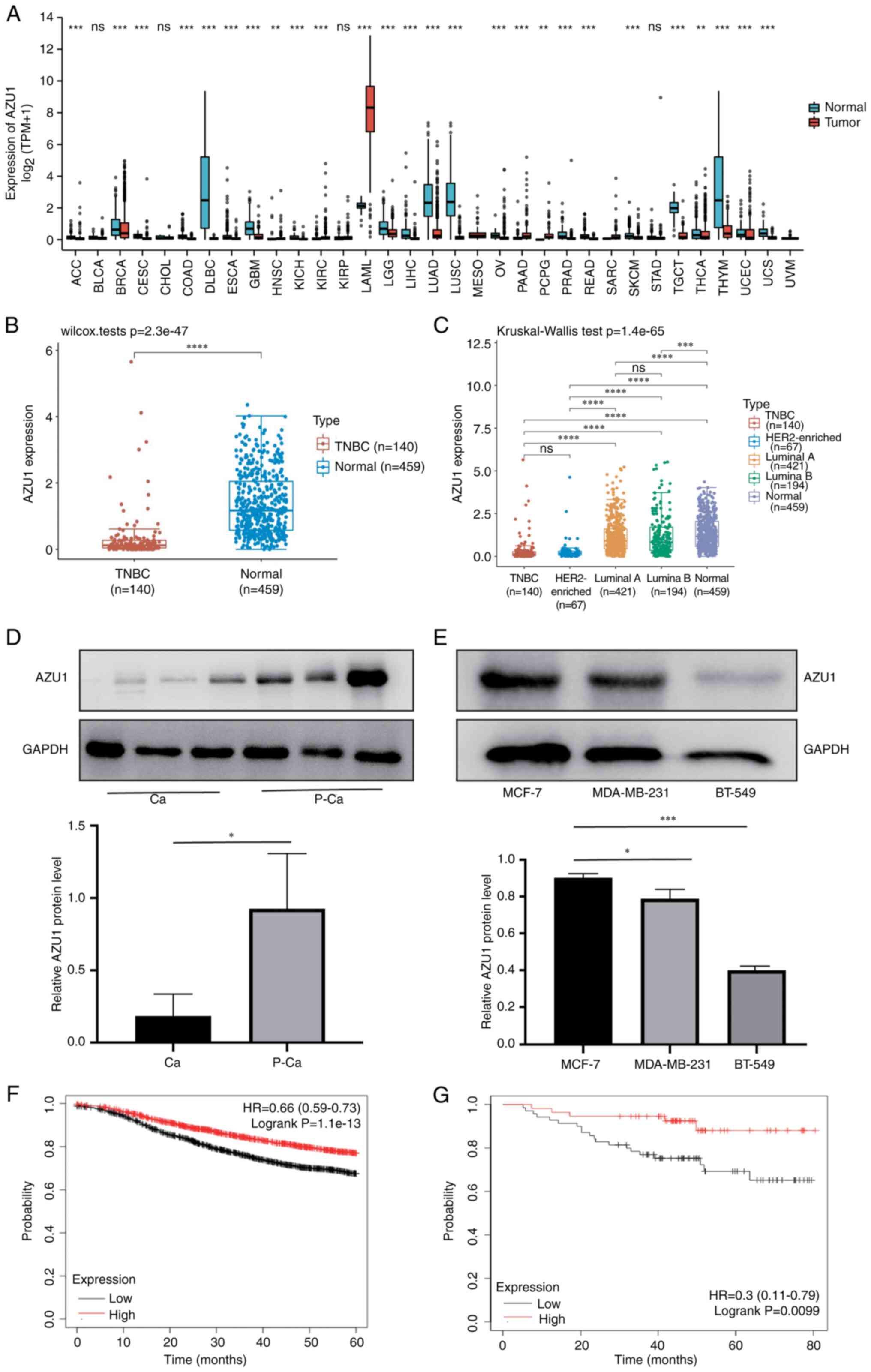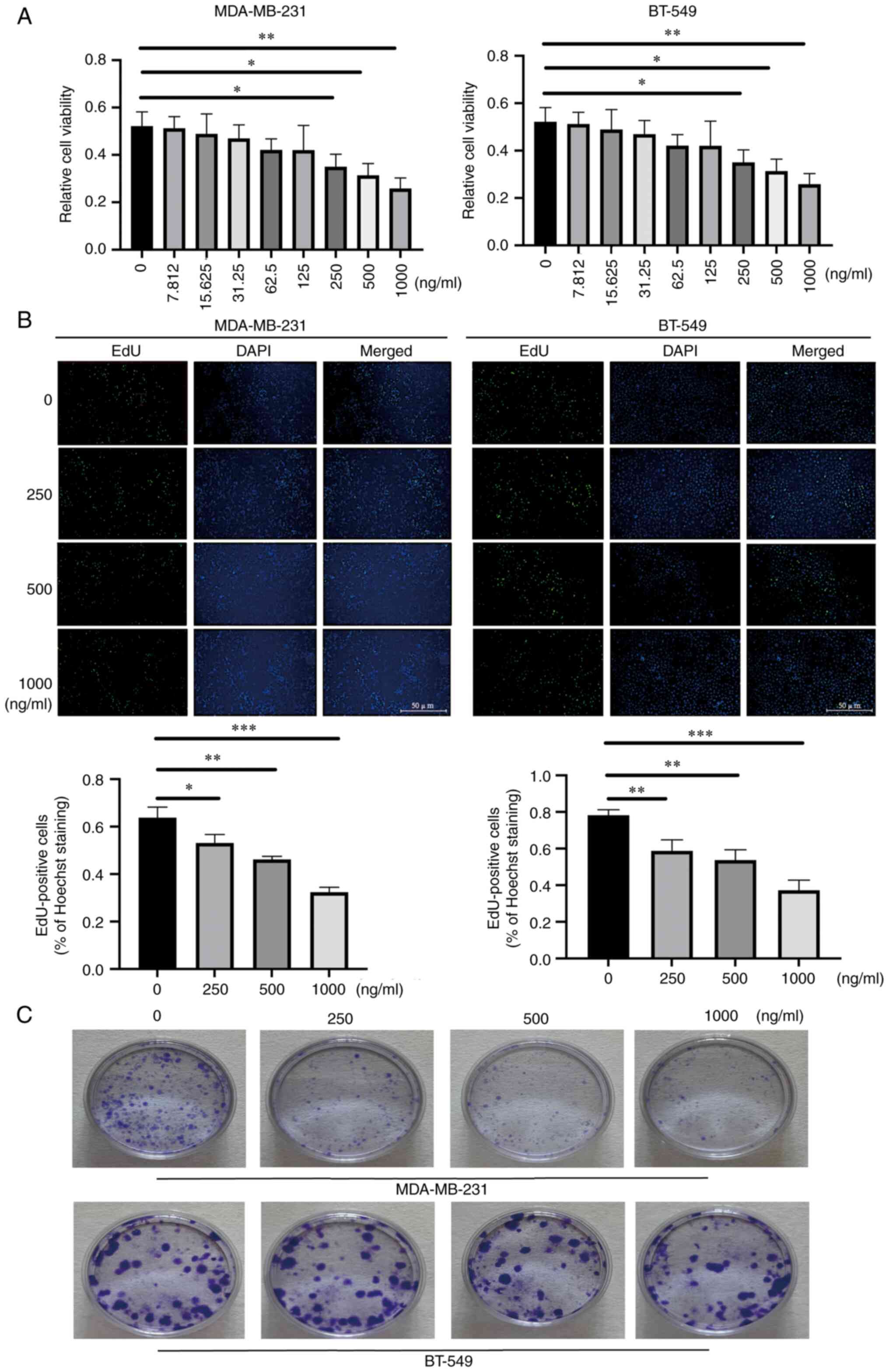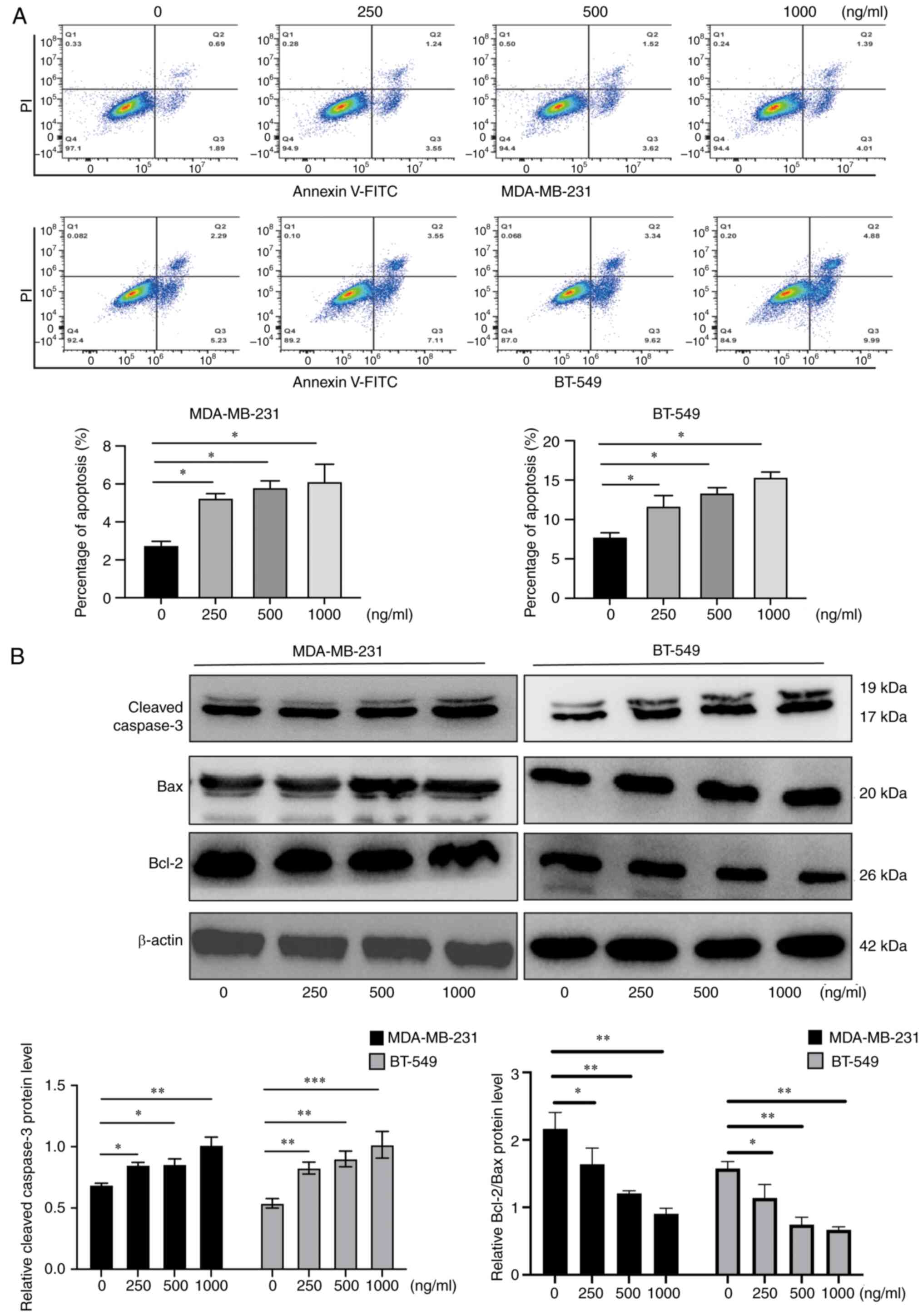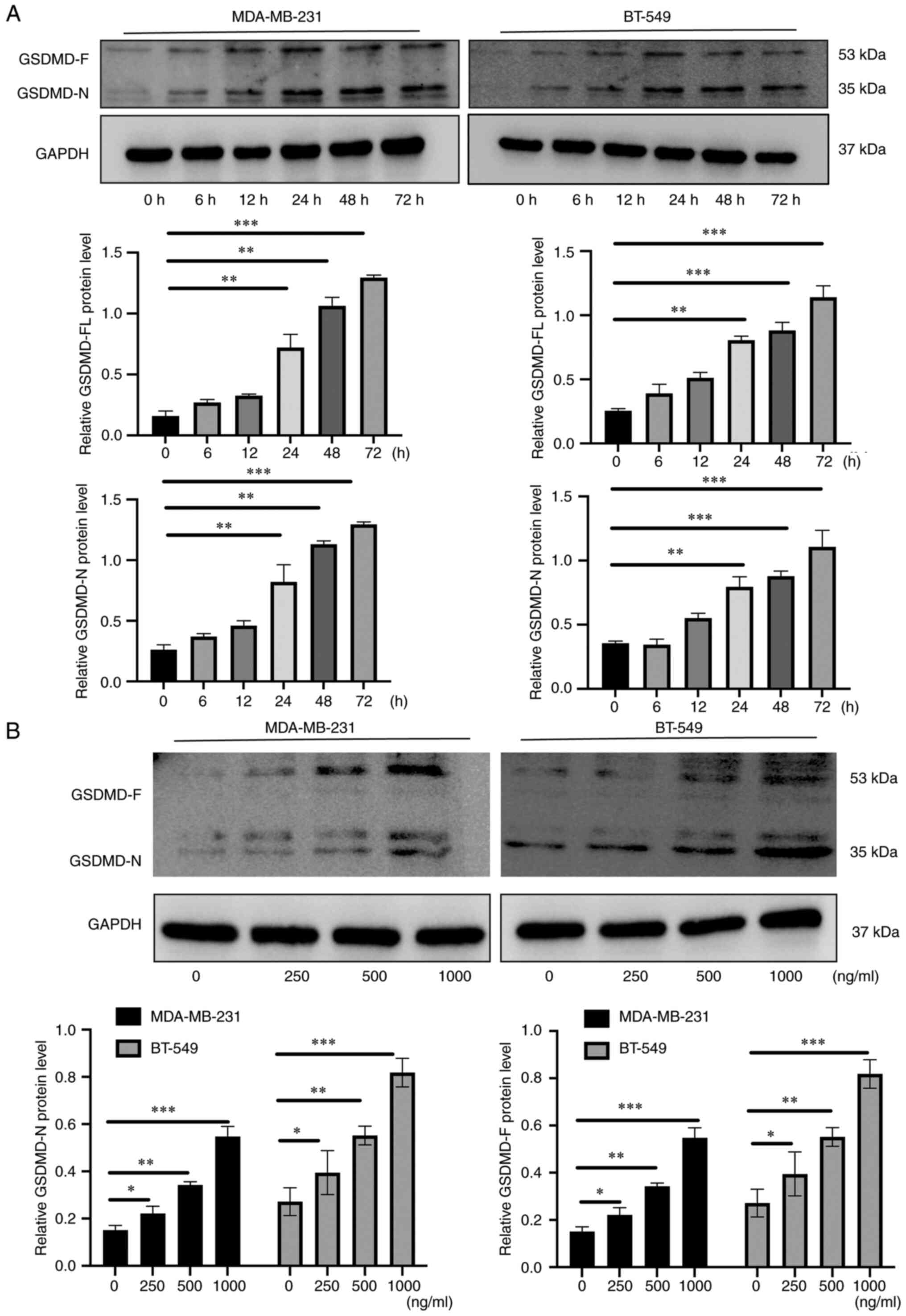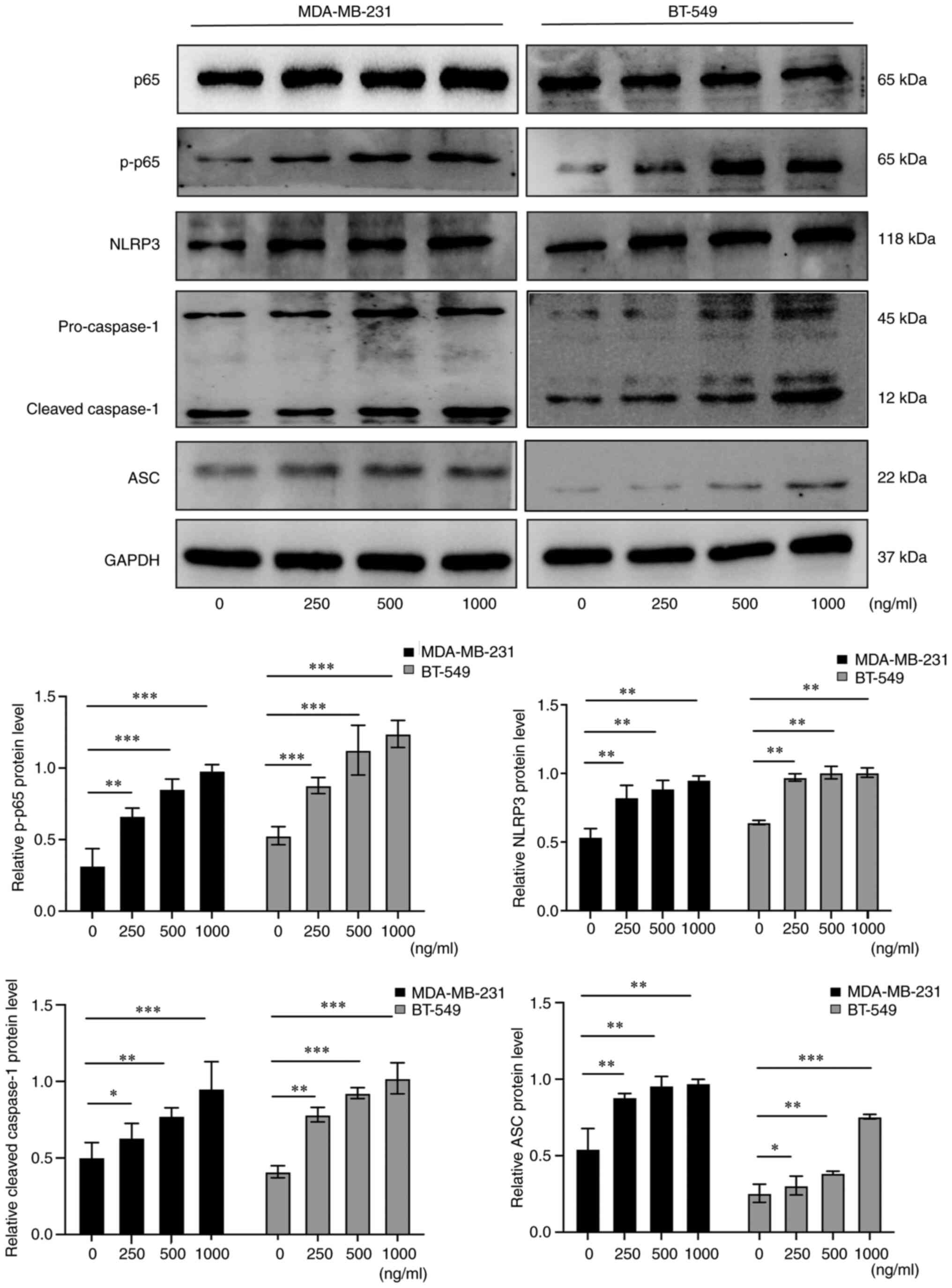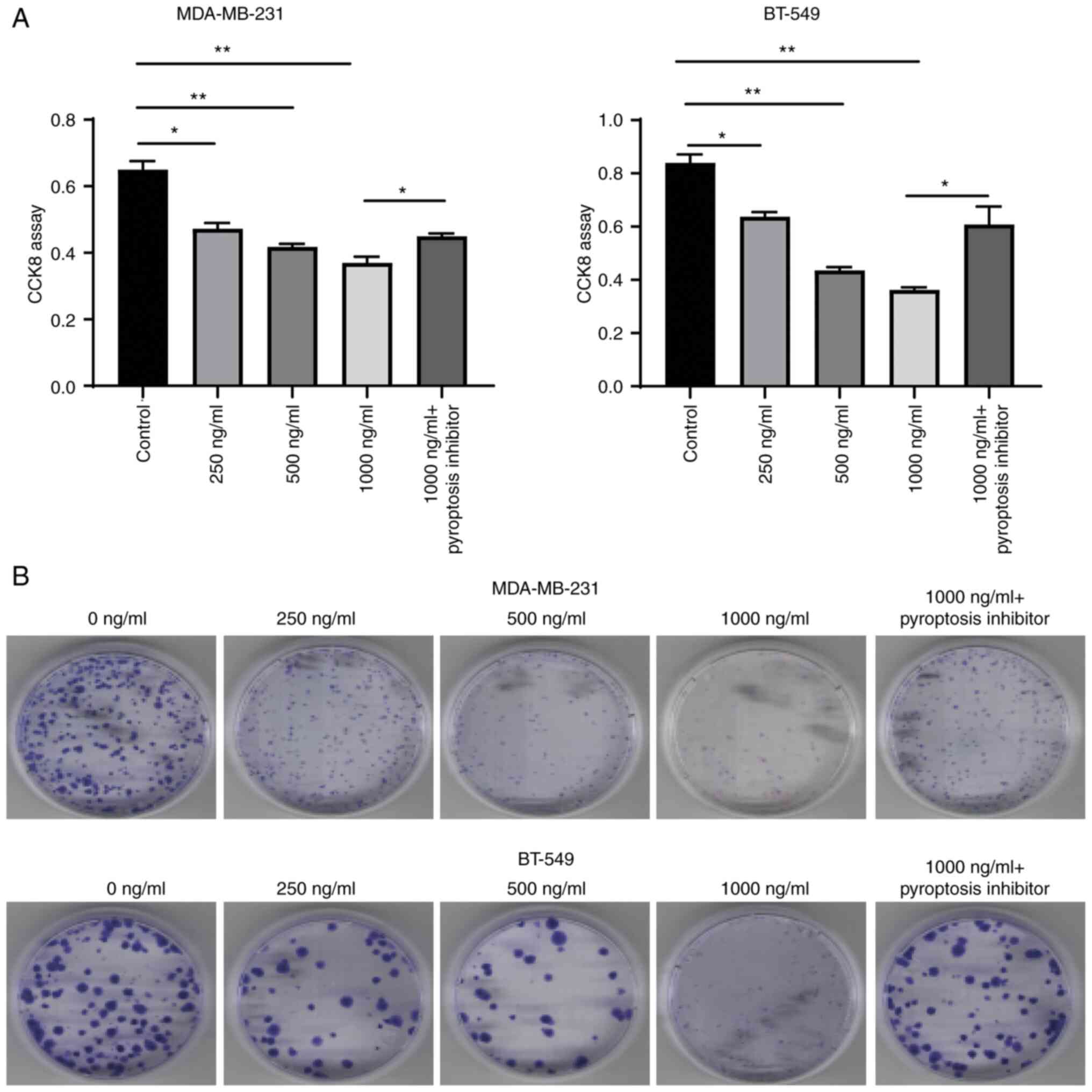Azurocidin 1 inhibits the aberrant proliferation of triple‑negative breast cancer through the regulation of pyroptosis
Corrigendum in: /10.3892/or.2024.8708
- Authors:
- Published online on: September 4, 2023 https://doi.org/10.3892/or.2023.8625
- Article Number: 188
-
Copyright: © Lei et al. This is an open access article distributed under the terms of Creative Commons Attribution License.
Abstract
Introduction
Breast cancer (BC) is an epithelial-derived malignancy occurring in the ducts or lobules of the breast (1). According to the 2018 Global Cancer Data report, BC is the most common form of cancer in women and is second only to lung cancer in terms of cancer-related mortality (2). Globally, BC is the most common cancer in women worldwide and accounted for 2.261 million new cases and 685,000 cancer-related deaths in 2020, which corresponded to 24.5% of all new cancer cases and 15.5% of cancer-related deaths in women (3). Based on gene expression profiles with distinct clinical outcomes, BC can be divided into four subtypes, namely luminal A, luminal B, human epidermal growth factor receptor 2 (HER2)-enriched and triple-negative BC (TNBC) (4). TNBC is a subtype that lacks estrogen receptor, progesterone receptor and HER2, which accounts for 10–17% of all BC cases (5,6). TNBC is reported to be a highly heterogeneous form of tumor characterized by an aggressive clinical course and increased likelihood of recurrence (7).
Emerging evidence has revealed various roles of pyroptosis in cancer pathogenesis and progression (8). Li et al demonstrated that pyroptosis is closely related to the initiation and development of cervical cancer (9). Wan et al revealed pyroptosis could trigger antitumor immunity and represent a promising new strategy to potentiate cancer immunotherapy (10). Gasdermin D (GSDMD) expression, together with the upstream components of the NLRP3 inflammasome complex, has been revealed to be closely associated with the occurrence of pyroptosis in numerous cancers (11,12).
Pyroptosis is pro-inflammatory, thus, it could activate the immune system and suppress tumor immune escape (13). Therefore, exploring new targets to enhance pyroptosis may be a new potential strategy to treat TNBC. Azurocidin 1 (AZU1) is a heparin-binding protein which has been reported to be aberrantly expressed in various tumors (14). It is a neutrophil-derived granule glycoprotein stored in secretory vesicles and azurophil granules of neutrophils which was discovered and isolated by Shafer et al (15). As an inflammatory mediator, AZU1 can increase the permeability of vascular endothelial cells, thus leading to vascular leakage and neutrophil extravasation (16). In addition, it could also activate inflammatory cells to release pro-inflammatory factors and cause systemic inflammatory response syndrome in severe cases, such as sepsis, in which the expression level of AZU1 is positively associated with the severity of disease (17,18). However, its role in TNBC remains unclear.
In the present study, the differential expression of AZU1 in non-BCs and BCs was firstly analyzed using The Cancer Genome Atlas (TCGA) and TIMER2.0 databases and the expression level of AZU1 in patients with TNBC was validated using western blot analysis. Subsequently, exogenous AZU1 was used to stimulate TNBC cell lines and investigate the proliferation and pyroptosis of AZU1 exerted on TNBC cells. Collectively, the findings of the present study revealed that AZU1 inhibited the aberrant proliferation of TNBC through the regulation of pyroptosis.
Materials and methods
Bioinformatic analysis
Pan-cancer analysis was conducted using TIMER2.0 database (http://timer.cistrome.org//). The differential level of AZU1 between normal tissues and BCs were analyzed using TCGA database (https://www.cancer.gov/ccg/research/genome-sequencing/tcga). One-way survival analysis was performed based on Kaplan-Meier plotter (https://kmplot.com/analysis/). Overall survival, first progression survival and post-progression survival were used as indicators for survival analysis.
BC cell culture
MDA-MB-231 (TNBC), MCF-7 (luminal A) and BT-549 (TNBC) cell lines were cultured in high-sugar DMEM or RPMI-1640 containing 10% fetal bovine serum (FBS; all from Zhejiang Ginocell Biological Technology Co., Ltd.; www.genomcell.com) plus 1% streptomycin/penicillin at 37°C in an environment of 5% CO2. Subsequently, the cells were pre-treated with 50 µM pyroptosis inhibitor (VX765; MedChemExpress) which was prepared in DMSO and was further diluted in cell culture medium for 2 h, followed by the exposure to various concentrations (0, 250, 500 and 1,000 ng/ml) of AZU1 (Beijing Solarbio Science & Technology Co., Ltd.) for 24 h at 37°C in an environment of 5% CO2. Then, 10 µl of Cell Counting Kit-8 (CCK-8; Beyotime Institute of Biotechnology) reagent was added to each well and incubated at 37°C for 2 h to detect the viability of BC cell lines.
Patients and specimens
The three samples of TNBC paired with adjacent normal mammary tissues were obtained from surgical specimens of patients with BC (aged, 67, 47 and 71 years) at Hunan Provincial People's Hospital (Changsha, China) from September 2021 to August 2022. The inclusion criteria were as follows: i) Patients with pathologically confirmed TNBC (19); ii) patients >18 years old; iii) patients with no indication for surgery; and iv) patients with no acute or chronic inflammation, hematological and autoimmune diseases. The exclusion criteria were as follows: i) Patients with other malignant tumors; and ii) patients with severe heart, brain or kidney diseases. Samples were frozen in liquid nitrogen immediately after surgical removal and maintained at −80°C until protein extraction. All studies were approved (approval no. 2021-036) by the Institutional Ethics Committee of Hunan Provincial People's Hospital (Changsha, China), and written informed consent was obtained from all the patients.
Protein preparation and western blot analysis
Proteins were extracted and harvested from MDA-MB-231, MCF-7 and BT-549 cell lines with radio immunoprecipitation assay lysis buffer (Beyotime Institute of Biotechnology). The isolated proteins were centrifuged at 10,000 × g for 10 min at 4°C. A BCA assay was then used to measure protein concentration and densitometry was detected using microplate reader (Biotek ELX808). Total protein (20 µg per lane) was separated on a 10% sodium dodecyl sulfate-polyacrylamide gel electrophoresis and transferred to a polyvinylidene fluoride membrane (PVDF). The PVDF membrane was soaked in 5% skim milk which was dissolved in Tris-buffered saline with Tween-20 (TBST; containing 2% Tween-20) for 1 h at room temperature. Subsequently, the soaked PVDF membrane was incubated overnight at 4°C with a rabbit polyclonal antibody against β-actin (product no. 4970) or GAPDH (product no. 92310; both from Cell Signaling Technology, Inc.), GSDMD (cat. no. ab219800; Abcam), p65 NF-κB (cat. no. 310099) and p-p65 NF-κB (cat. no. 310013; both from Chengdu Zhengneng Biotechnology, Inc.; www.zen-bio.cn), caspase-1 (cat. no. ab179515; Abcam), apoptosis-associated speck-like protein containing a CARD (ASC; cat. no. DF6304; Affinity Biosciences), NLRP3 (cat. no. A5652; Abclonal Biotech Co., Ltd.), cleaved caspase-3 (product no. 9664), Bax (product no. 2772) and Bcl-2 (4223; all from Cell Signaling Technology, Inc.) at a dilution of 1:1,000 (for GSDMD, p65, p-p65, ASC, NLRP3, cleaved caspase-3, Bax and Bcl-2) or 1:2,000 (for GAPDH and β-actin). Subsequently, the membrane was washed with TBST three times and incubated with a secondary HRP goat anti-rabbit antibody (cat. no. AS014; Abclonal Biotech Co., Ltd.) for 1 h at room temperature at a dilution of 1:5,000. Similarly, the PVDF membrane was washed three times again using TBST. Finally, specific bands were visualized using a chemiluminescent substrate (cat. no. P0018M; Beyotime Institute of Biotechnology) and detected using the Omega Lum C Gel Imaging System. The relative expression of proteins was analyzed using ImageJ 1.48v (National Institutes of Health).
Colony formation assay
For the colony formation assay, 3×102 MDA-MB-231 or BT-549 cells were plated into 60-mm culture plates, and cultured in DMEM or RPMI-1640 culture medium supplemented with 10% FBS. The cells were then treated with various concentrations of AZU1 (0, 250, 500 and 1,000 ng/ml). After 14 days of incubation at 37°C in a 5% CO2 environment, cells were fixed with 4% paraformaldehyde for 30 min and stained with 0.1% crystal violet for 10 min at room temperature. Finally, the number of colonies that contained >50 cells were counted manually. All experiments were performed at least three times.
5-Ethynyl-2′-deoxyuridine (EdU) proliferation assay
A total of 5×103 MDA-MB-231 or BT-549 cells were seeded into 24-well plates and cultured in DMEM or RPMI-1640 complete culture medium supplemented with 10% FBS, followed by treatment with 0, 250, 500, 100 ng/ml of AZU1 for 24 h at 37°C in a 5% CO2 environment. An EdU proliferation assay was then used to examine the proliferation capability of MDA-MB-231 or BT-549 cells, according to the manufacturer's protocol. Firstly, the cells were incubated with 10 µM EdU (product no. CX002; Shanghai Epizyme Biotech Co., Ltd.) for 2 h at 37°C in a 5% CO2 environment. Subsequently, the medium was removed and fixed with 4% paraformaldehyde for 15 min at room temperature. The cells were then permeabilized with Triton X-100 for 5 min (cat. no. T8200; Beijing Solarbio Science & Technology Co., Ltd.) and 500 µl Click Additive Solution (included in the EdU kit) was added at room temperature. A total of 500 µl DAPI solution (cat. no. D1306; Thermo Fisher Scientific, Inc.) was added after 30 min and the fluorescence intensity was measured using a fluorescence microscope at a magnification of 40.
Apoptosis analysis
The apoptosis of MDA-MB-231 or BT-549 cells were analyzed using flow cytometry. Firstly, the cells were trypsinized with 0.25% trypsin (Beijing Solarbio Science & Technology Co., Ltd.) and washed with 1X PBS twice. Subsequently, the cells were resuspended in PBS and 5 µl Annexin V-fluorescein isothiocyanate and propidium iodide [cat. no. AT101; Hangzhou Multisciences (Lianke) Biotech Co., Ltd.] were added to the sample. After 15 min of incubation at room temperature, the apoptosis of the cells was detected using a flow cytometer (CytoFLEX; Beckman Coulter, Inc.). The acquired data was analyzed using FlowJo v10.8.1 (BD Biosciences). All experiments were performed at least three times.
Statistical analysis
All data are presented as the mean ± standard deviation and were statistically analyzed using GraphPad Prism 8.0 software (GraphPad Software Inc.; Dotmatics). The Student's unpaired t-test was used to determine statistical significance between two groups. Statistical analyses for more than two groups were performed using one-way analysis of variance (ANOVA), followed by Tukey's post hoc test. P<0.05 was considered to indicate a statistically significant difference.
Results
AZU1 level is negatively associated with the survival rate of TNBC patients
To clarify the role of AZU1 in tumor growth, pan-cancer analysis was conducted in tumors and adjacent normal tissues using TIMER2.0. The results revealed that AZU1 mRNA expression was strongly downregulated in BC, especially in TNBC (Fig. 1A-C). In order to further validate its expression, the cancerous tissues (Ca) and para-cancerous tissues (P-Ca) of patients with TNBC were isolated for western blot analysis. The results validated the bioinformatics analysis data (Fig. 1D and E). To analyze the association between AZU1 expression level and prognosis of patients with TNBC, survival analysis was performed in the present study. In Fig. 1F and G, the abscissa axis represents the survival time and the vertical axis indicates the survival rate of patients with BC or TNBC. In addition, the red line indicates the BC or TNBC patients with a high expression level of AZU1, while the black line indicates the patients with BC or TNBC with a low expression level of AZU1 (Fig. 1F and G). The results of the survival analysis revealed that patients with TNBC and a low expression level of AZU1 exhibited a low survival rate (Fig. 1G). These data suggested that AZU1 exerted a vital role in the progression of TNBC.
AZU1 inhibits the proliferation and colony formation of TNBC tumor cells
To further explore the role that AZU1 exerted in the pathogenesis of TNBC, various concentrations of AZU1 (0, 7.8, 15.6, 31.2, 62.5, 125, 250, 500 and 1,000 ng/ml) were utilized to stimulate the cell lines of TNBC (MDA-MB-231 and BT-549 cells). CCK-8 assays demonstrated that a high concentration of AZU1 (above 250 ng/ml) was able to inhibit the proliferation of MDA-MB-231 and BT-549 cells (Fig. 2A). Therefore, 250, 500 and 1,000 ng/ml AZU1 was used in the subsequent experiments. The results of the EdU assays also showed that a higher concentration of AZU1 led to a weak proliferation capability of the cells (Fig. 2B). The colony formation assay results were highly similar with the EdU data (Fig. 2C).
AZU1 promotes apoptosis of TNBC tumor cells
For further exploration of the underlying mechanism of AZU1, exerted in TNBC progression, MDA-MB-231 cells and BT-549 cells were treated with various concentrations of AZU1 and flow cytometry was conducted to detect the apoptosis levels. As revealed in Fig. 3A, a high concentration of AZU1 led to an increased percentage of apoptosis (Fig. 3A). Subsequently, the expression levels of apoptosis associated proteins, including anti-apoptotic and pro-apoptotic-related proteins, were detected using western blot analysis. As demonstrated in Fig. 3B, the anti-apoptotic-related protein, Bcl-2, was decreased following AZU1 treatment, whereas the pro-apoptotic proteins, cleaved caspase-3 and Bax, were increased in MDA-MB-231 cells and BT-549 cells. Collectively, the data of the present study showed that high concentrations of AZU1 promoted the apoptosis of TNBC cell lines.
AZU1 induces pyroptosis of TNBC cells lines
Pyroptosis, a form of programmed cell death, has been revealed to exert crucial roles in modulating the aberrant proliferation of tumor cells (20). As GSDMD is its specific biomarker, the protein level of GSDMD in TNBC cell lines was investigated. The results revealed that the effects of AZU1 on the levels of GSDMD, both the full-length GSDMD (GSDMD-FL) and the N-terminal cleavage product of GSDMD (GSDMD-N), were dose- and time-dependent, especially after 24 h of the treatment (Fig. 4A and B).
AZU1 promotes the pyroptosis of TNBC cell lines through the modulation of the NF-κB/NLRP3 axis
As the NF-κB/NLRP3 axis is an effective and functional regulator of pyroptosis (21), the role that AZU1 exerted on the NF-κB/NLRP3 axis was subsequently assessed. Firstly, TNBC cell lines were treated with various concentrations of AZU1 and western blot analysis was utilized to detect the expression of p-65 NF-κB, NLRP3, caspase-1 and ASC. As depicted in Fig. 5, p-65 NF-κB, NLRP3, caspase-1 and ASC protein levels revealed a significant increase under the treatment of AZU1 after 24 h. These findings indicated that AZU1 promoted the pyroptosis of TNBC cell lines through the modulation of the NF-κB/NLRP3 axis.
AZU1 inhibits TNBC proliferation through the modulation of pyroptosis
As it was demonstrated that AZU1 promoted the pyroptosis of TNBC cell lines through the modulation of the NF-κB/NLRP3 axis, next, it was further explored whether AZU1 functioned to inhibit the proliferation of TNBC cell lines through pyroptosis. Therefore, TNBC cell lines were treated with a pyroptosis inhibitor and CCK-8 along with colony formation assay were used to assess the proliferation of the cells. The results revealed that the proliferation of TNBC cell lines was significantly inhibited when treated with various concentrations of AZU1, which was partially reversed when the cells were co-incubated with the pyroptosis inhibitor and AZU1 (Fig. 6). These findings suggested that AZU1 inhibited TNBC proliferation through the modulation of pyroptosis.
Discussion
Despite the recent great advances in the treatment of TNBC, an effective treatment remains elusive. Patients with TNBC are still characterized by a poor prognosis and high recurrence rate due to the complex pathological features (22). Therefore, it is urgent to identify the potential molecular mechanism and explore novel therapeutic strategies. Luminal A is the most frequent BC molecular subtype (4), thus it was selected as a control. Furthermore, MDA-MB-231 and BT-549 cell lines are the most commonly used cell lines in TNBC studies (23), therefore, they were selected for the experiments conducted. In the present study, two well-known TNBC cell lines, MDA-MB-231 and BT-549 were used, and preliminarily revealed that high concentrations of AZU1 exposure induced GSDMD-dependent pyroptosis through the modulation of the NF-κB/NLRP3/caspase-1/GSDMD axis. The findings of the present study provided a novel perspective for exploring the therapeutic interventions of TNBC.
The tumor microenvironment (TME) is highly complex and heterogeneous, and is composed of various components, such as the extracellular matrix, cancer cells and neutrophils (24). It is indispensable for the initiation and progression of TNBC. The induction of proliferation, angiogenesis, inhibition of apoptosis, immune suppression and evasion of immune surveillance are intrinsically linked to the TME (25). AZU1, has been identified as a chemoattractant and activator of monocytes and macrophages (26), as it is stored in the secretory vesicles and primary granules of neutrophils (27). Tumor-associated macrophages are known to be attracted by chemokines and cytokines produced by tumor cells, leading to the construction of the tumor microenvironment and production of stimuli which contribute to cell pyroptosis (28). However, to date, a limited number of studies have revealed its roles in tumor growth. In the present study, its effect on the pathogenesis of TNBC was addressed, to the best of the authors' knowledge, for the first time. The bioinformatics analysis conducted, demonstrated that TNBC and HER2-enriched patients have a lower expression of AZU1 than healthy individuals and patients with other subtypes of BC, and the western blot analysis conducted in the present study validated this observation. These data indicated that AZU1 played an important role in the pathogenesis of TNBC. As TNBC has the worst prognosis among all BC subtypes (7), the effects of AZU1 exerted in TNBC were investigated. However, the roles AZU1 played in the HER2-enriched subtype warrant further investigation. A previous study revealed that AZU1 was able to decrease the cell viability and increase cell death with increasing concentrations and treatment time (29). The results of the present study also demonstrated that the cell viability was suppressed in a time- and dose-dependent manner by AZU1 exposure. Apoptosis is an important process for the inhibition of aberrant proliferation (30). During apoptosis, pro-apoptotic proteins (such as Bcl-2) were unleashed via their upregulation. When saturated, they can activate Bax, which forms pores that cause mitochondrial outer membrane permeabilization and result in the release of cytochrome c (31). Cytochrome c binds apoptotic peptidase activating factor 1 in the cytosol to form the apoptosome, which serves as a platform for the activation of caspase-9, and then continues in order to activate the effector caspase-3 to dismantle the cell and prepare it for phagocytosis (32). Therefore, the expression of Bcl-2, Bax and caspase-3 were detected in the present study. The results revealed that AZU1, in concentrations over 250 ng/ml, upregulated the pro-apoptotic-associated protein expression levels and suppressed the anti-apoptotic-related protein expression levels, thus resulting in an increase in apoptosis, suggesting that AZU1 played a role in protection against tumor growth.
Regulation of cell death by AZU1 exposure was further examined, as the characteristics of cell death are different from apoptosis morphologically, with cell swelling and rounding emerging from the plasma membrane (33,34). The results revealed that high concentrations of AZU1 not only contributed to apoptosis, but also pyroptosis. To date, numerous studies have revealed that pyroptosis is a key regulator which significantly inhibits the aberrant proliferation of tumor cells (20,35). Previous research has focused on the in-depth understanding of the underlying regulatory mechanism of pyroptosis (36). GSDMD is an important pore-forming protein that has been extensively studied in pyroptosis (37). In the present study, it was revealed that the GSDMD N-terminal fragment was significantly increased in AZU1-treated MDA-MB-231 and BT-549 cells, indicating that GSDMD was cleaved under AZU1 exposure. Moreover, NLRP3 inflammasome complex activation was observed in response to AZU1 exposure in vitro, as reflected by the elevated expression of NLRP3, caspase-1, ASC and p-65 NF-κB. Collectively, these data provided direct evidence that AZU1 could induce pyroptosis through the modulation of the p65 NF-κB/NLRP3/caspase-1/GSDMD axis.
In conclusion, it was revealed for the first time, to the best of the authors' knowledge, that AZU1 exposure promotes pyroptosis through the modulation of the p65 NF-κB/NLRP3/caspase-1/GSDMD axis in TNBC in vitro. The findings of the present study unveiled a novel mechanism of AZU1-induced pyroptosis in TNBC, which may aid in developing new strategies for therapeutic interventions in TNBC. Although the current results expanded the knowledge of the authors on the mechanism of pyroptosis induced by AZU1 exposure, there are still some limitations in the present study. Since both GSDMD and gasdermin E (GSDME) are important pyroptotic products (38), only the level of GSDMD-mediated pyroptosis in TNBC was investigated. Therefore, further research is required to explore whether GSDME-mediated pyroptosis is involved in the AZU1-induced antitumor effect of TNBC.
Acknowledgements
Not applicable.
Funding
The present study was financially supported by the National Natural Science Foundation of China (grant no. 82102278), the Natural Science Foundation of Hunan Province (grant nos. 2021JJ40928 and 2021JJ70090), the Project of Changsha Natural Science Foundation (grant no. kq2202023), the Huxiang High-Level Talent Gathering Project (grant no. 2019RS1067) and the Major Special Project of Hunan Province (grant no. 2020SK1014).
Availability of data and materials
The datasets used and/or analyzed during the current study are available from the corresponding authors on reasonable request.
Authors' contributions
YL and YJ conceived and designed the project. SLi and SLei, WeiweiX and QJ acquired and analyzed the data. FC, SY, WenX, JC, JW and LZ analyzed and interpreted the data. SLi and SLei confirm the authenticity of all the raw data. All authors read and approved the final version of the manuscript.
Ethics approval and consent to participate
Informed written consent were obtained from all patients. The present study was approved (approval no. 2021-036) by the Institutional Ethics Committee of Hunan Provincial People's Hospital (Changsha, China).
Patient consent for publication
Not applicable.
Competing interests
The authors declare that they have no competing interests.
References
|
Tharmapalan P, Mahendralingam M, Berman HK and Khokha R: Mammary stem cells and progenitors: Targeting the roots of breast cancer for prevention. EMBO J. 38:e1008522019. View Article : Google Scholar : PubMed/NCBI | |
|
Bray F, Ferlay J, Soerjomataram I, Siegel RL, Torre LA and Jemal A: Global cancer statistics 2018: GLOBOCAN estimates of incidence and mortality worldwide for 36 cancers in 185 countries. CA Cancer J Clin. 68:394–424. 2018. View Article : Google Scholar : PubMed/NCBI | |
|
Katsura C, Ogunmwonyi I, Kankam HK and Saha S: Breast cancer: Presentation, investigation and management. Br J Hosp Med (Lond). 83:1–7. 2022. View Article : Google Scholar : PubMed/NCBI | |
|
Prat A, Pineda E, Adamo B, Galván P, Fernández A, Gaba L, Díez M, Viladot M, Arance A and Muñoz M: Clinical implications of the intrinsic molecular subtypes of breast cancer. Breast. 24 (Suppl 2):S26–S35. 2015. View Article : Google Scholar : PubMed/NCBI | |
|
Yin L, Duan JJ, Bian XW and Yu SC: Triple-negative breast cancer molecular subtyping and treatment progress. Breast Cancer Res. 22:612020. View Article : Google Scholar : PubMed/NCBI | |
|
Zhu Y, Zhu X, Tang C, Guan X and Zhang W: Progress and challenges of immunotherapy in triple-negative breast cancer. Biochim Biophys Acta Rev Cancer. 1876:1885932021. View Article : Google Scholar : PubMed/NCBI | |
|
Cho B, Han Y, Lian M, Colditz GA, Weber JD, Ma C and Liu Y: Evaluation of racial/ethnic differences in treatment and mortality among women with triple-negative breast cancer. JAMA Oncol. 7:1016–1023. 2021. View Article : Google Scholar : PubMed/NCBI | |
|
Zhang H, Chen Z, Zhou J, Gu J, Wu H, Jiang Y, Gao S, Liao Y, Shen R, Miao C and Chen W: NAT10 regulates neutrophil pyroptosis in sepsis via acetylating ULK1 RNA and activating STING pathway. Commun Biol. 5:9162022. View Article : Google Scholar : PubMed/NCBI | |
|
Li K, Qiu J, Pan J and Pan JP: Pyroptosis and its role in cervical cancer. Cancers (Basel). 14:57642022. View Article : Google Scholar : PubMed/NCBI | |
|
Wan SC, Ye MJ, Yang QC, Zhang T, Zhang MJ, Ma XB, Xu JM, Wang S, Wu ZZ, Yang LL, et al: Diselenide-based dual-responsive prodrug as pyroptosis inducer potentiates cancer immunotherapy. Adv Healthc Mater. 12:e22021352023. View Article : Google Scholar : PubMed/NCBI | |
|
Wang C, Yang T, Xiao J, Xu C, Alippe Y, Sun K, Kanneganti TD, Monahan JB, Abu-Amer Y, Lieberman J and Mbalaviele G: NLRP3 inflammasome activation triggers gasdermin D-independent inflammation. Sci Immunol. 6:eabj38592021. View Article : Google Scholar : PubMed/NCBI | |
|
Swanson KV, Deng M and Ting JP: The NLRP3 inflammasome: Molecular activation and regulation to therapeutics. Nat Rev Immunol. 19:477–489. 2019. View Article : Google Scholar : PubMed/NCBI | |
|
Man SM, Karki R and Kanneganti TD: Molecular mechanisms and functions of pyroptosis, inflammatory caspases and inflammasomes in infectious diseases. Immunol Rev. 277:61–75. 2017. View Article : Google Scholar : PubMed/NCBI | |
|
Jingushi K, Uemura M, Ohnishi N, Nakata W, Fujita K, Naito T, Fujii R, Saichi N, Nonomura N, Tsujikawa K and Ueda K: Extracellular vesicles isolated from human renal cell carcinoma tissues disrupt vascular endothelial cell morphology via azurocidin. Int J Cancer. 142:607–617. 2018. View Article : Google Scholar : PubMed/NCBI | |
|
Shafer WM, Martin LE and Spitznagel JK: Cationic antimicrobial proteins isolated from human neutrophil granulocytes in the presence of diisopropyl fluorophosphate. Infect Immun. 45:29–35. 1984. View Article : Google Scholar : PubMed/NCBI | |
|
Di Gennaro A, Kenne E, Wan M, Soehnlein O, Lindbom L and Haeggström JZ: Leukotriene B4-induced changes in vascular permeability are mediated by neutrophil release of heparin-binding protein (HBP/CAP37/azurocidin). FASEB J. 23:1750–1757. 2009. View Article : Google Scholar : PubMed/NCBI | |
|
Naito T, Jingushi K, Ueda K and Tsujikawa K: Azurocidin is loaded into small extracellular vesicles via its N-linked glycosylation and promotes intravasation of renal cell carcinoma cells. FEBS Lett. 595:2522–2532. 2021. View Article : Google Scholar : PubMed/NCBI | |
|
Sun JK, Shen X, Sun XP, Wang X, Zhang WH, Shi QK and Mu XW: Heparin-binding protein as a biomarker of gastrointestinal dysfunction in critically ill patients: A retrospective cross-sectional study in China. BMJ Open. 10:e0363962020. View Article : Google Scholar : PubMed/NCBI | |
|
Eisenhauer EA, Therasse P, Bogaerts J, Schwartz LH, Sargent D, Ford R, Dancey J, Arbuck S, Gwyther S, Mooney M, et al: New response evaluation criteria in solid tumours: Revised RECIST guideline (version 1.1). Eur J Cancer. 45:228–247. 2009. View Article : Google Scholar : PubMed/NCBI | |
|
Zhang J and Wei K: Necrosulfonamide reverses pyroptosis-induced inhibition of proliferation and differentiation of osteoblasts through the NLRP3/caspase-1/GSDMD pathway. Exp Cell Res. 405:1126482021. View Article : Google Scholar : PubMed/NCBI | |
|
Yan S, Jiang Y, Yu T, Hou C, Xiao W, Xu J, Wen H, Wang J, Li S, Chen F, et al: Shengjiang San alleviated sepsis-induced lung injury through its bidirectional regulatory effect. Chin Med. 18:392023. View Article : Google Scholar : PubMed/NCBI | |
|
Xie Y, Hu Y, Zhou N, Yao C, Wu L, Liu L and Chen F: CAR T-cell therapy for triple-negative breast cancer: Where we are. Cancer Lett. 491:121–131. 2020. View Article : Google Scholar : PubMed/NCBI | |
|
Xie Q, Yang Z, Huang X, Zhang Z, Li J, Ju J, Zhang H and Ma J: Ilamycin C induces apoptosis and inhibits migration and invasion in triple-negative breast cancer by suppressing IL-6/STAT3 pathway. J Hematol Oncol. 12:602019. View Article : Google Scholar : PubMed/NCBI | |
|
Del Prete A, Schioppa T, Tiberio L, Stabile H and Sozzani S: Leukocyte trafficking in tumor microenvironment. Curr Opin Pharmacol. 35:40–47. 2017. View Article : Google Scholar : PubMed/NCBI | |
|
Blanco M, Collazo-Lorduy A, Yanguas-Casás N, Calvo V and Provencio M: Unveiling the role of the tumor microenvironment in the treatment of follicular lymphoma. Cancers (Basel). 14:21582022. View Article : Google Scholar : PubMed/NCBI | |
|
Linder A, Soehnlein O and Akesson P: Roles of heparin-binding protein in bacterial infections. J Innate Immun. 2:431–438. 2010. View Article : Google Scholar : PubMed/NCBI | |
|
Fisher J and Linder A: Heparin-binding protein: A key player in the pathophysiology of organ dysfunction in sepsis. J Intern Med. 281:562–574. 2017. View Article : Google Scholar : PubMed/NCBI | |
|
Yang M, Li J, Gu P and Fan X: The application of nanoparticles in cancer immunotherapy: Targeting tumor microenvironment. Bioact Mater. 6:1973–1987. 2020. View Article : Google Scholar : PubMed/NCBI | |
|
Soehnlein O, Xie X, Ulbrich H, Kenne E, Rotzius P, Flodgaard H, Eriksson EE and Lindbom L: Neutrophil-derived heparin-binding protein (HBP/CAP37) deposited on endothelium enhances monocyte arrest under flow conditions. J Immunol. 174:6399–6405. 2005. View Article : Google Scholar : PubMed/NCBI | |
|
Pérez-Herrero E and Fernández-Medarde A: Advanced targeted therapies in cancer: Drug nanocarriers, the future of chemotherapy. Eur J Pharm Biopharm. 93:52–79. 2015. View Article : Google Scholar : PubMed/NCBI | |
|
Vervloessem T, Akl H, Tousseyn T, De Smedt H, Parys JB and Bultynck G: Reciprocal sensitivity of diffuse large B-cell lymphoma cells to Bcl-2 inhibitors BIRD-2 versus venetoclax. Oncotarget. 8:111656–111671. 2017. View Article : Google Scholar : PubMed/NCBI | |
|
Mendez DL, Akey IV, Akey CW and Kranz RG: Oxidized or reduced cytochrome c and axial ligand variants all form the apoptosome in vitro. Biochemistry. 56:2766–2769. 2017. View Article : Google Scholar : PubMed/NCBI | |
|
Jiang L, Li XP, Dai YT, Chen B, Weng XQ, Xiong SM, Zhang M, Huang JY, Chen Z and Chen SJ: Multidimensional study of the heterogeneity of leukemia cells in t(8;21) acute myelogenous leukemia identifies the subtype with poor outcome. Proc Natl Acad Sci USA. 117:20117–20126. 2020. View Article : Google Scholar : PubMed/NCBI | |
|
Kovacs SB and Miao EA: Gasdermins: Effectors of pyroptosis. Trends Cell Biol. 27:673–684. 2017. View Article : Google Scholar : PubMed/NCBI | |
|
Xia X, Wang X, Cheng Z, Qin W, Lei L, Jiang J and Hu J: The role of pyroptosis in cancer: pro-cancer or pro-‘host’? Cell Death Dis. 10:6502019. View Article : Google Scholar : PubMed/NCBI | |
|
Shi J, Zhao Y, Wang K, Shi X, Wang Y, Huang H, Zhuang Y, Cai T, Wang F and Shao F: Cleavage of GSDMD by inflammatory caspases determines pyroptotic cell death. Nature. 526:660–665. 2015. View Article : Google Scholar : PubMed/NCBI | |
|
Zuo Y, Chen L, Gu H, He X, Ye Z, Wang Z, Shao Q and Xue C: GSDMD-mediated pyroptosis: A critical mechanism of diabetic nephropathy. Expert Rev Mol Med. 23:e232021. View Article : Google Scholar : PubMed/NCBI | |
|
Chung C, Seo W, Silwal P and Jo EK: Crosstalks between inflammasome and autophagy in cancer. J Hematol Oncol. 13:1002020. View Article : Google Scholar : PubMed/NCBI |



